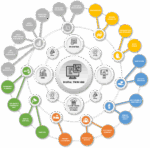
How Building Information Modeling (BIM) Has Revolutionized the Construction Industry
Building information modeling (BIM) is a process that generates and manages digital representations of buildings, in terms of both physical and functional characteristics. Companies that plan, design, construct, operate, and maintain diverse infrastructures use BMI to make reliable decisions about a building from construction to demolition.
BIM software allows engineers to essentially create a building on a computer before constructing it in the field. Our engineering professionals can transform drawings, plans, blueprints, and PDF files into true BIM models with rich details, clean layers, and references.
BIM and Construction Management

Building engineers face constant challenges of limited manpower, tight budgets, conflicting requests, and accelerated schedules. BIM helps these professionals detect issues in the early stages and identify the exact location of discrepancies. Some companies have begun developing BIMs in various detail levels, depending on the BIM application. BIM is also used to bridge the information loss gap between the design team, the construction team, and the building owner, allowing all parties to be on the same page at all times.
BIM and Material Costs

Not only does BIM make construction more efficient, but it also helps cut materials costs. Located in downtown Phoenix, the $339-million Maricopa County Court Tower was delivered on time and under budget thanks to BIM. Fourteen BIM models were completed early enough for the project so that spring and summer price hikes could be avoided. Similarly, hundreds of thousands of dollars in construction and administrative costs were saved constructing the MIT Cancer Research Center by using BIM models to purchase structural steel in advance and reduce the number of formal requests for information.
BIM Around the World
In the United States, BIM is often associated with Integrated Project Delivery (IPD), with a primary motivation to bring project teams together early on. The Canada BIM Council was established in 2008 to standardize the use of models in architecture, engineering, and construction. Public and private governing bodies in Europe have been pushing for more integrated adoption of BIM standards to improve software capabilities and cooperation in the industry. Throughout the world, studies are being conducted about how to improve network users’ authentication choices, geographic mapping systems, and cloud computing security.
“One of the greatest assets with BIM is having all the information in one place. No longer will the 3-D model be located in one application and the product information in another. Now, members of the building team can simply click on a product listing and review all of its properties,” said Stan Graveline, Vice President of Technical Services, Sika. “Product warranty information can also be stored in the BIM design file, making it easy to find if needed in the future.”
VIATechnik has extensive experience in BIM services and served their clients in various ways. In addition to utilizing BIM for coordination purposes, our team regularly works on point cloud to BIM conversions. While BIM coordination helps clients manage costs during the construction phase, our point cloud to BIM service help clients work with existing conditions, and allow design teams to minimize both the disruption to existing building conditions and also costs of the new designs. In practice, our point cloud team has helped create BIM models for industrial, oil and gas, and medical facilities. Instead of clients doing a manual survey and potentially guessing the location of various ducts, pipes, and electrical work, we give our clients a model that they can then use to build the design around. The future of BIM is bright – with all the various ways that the technology can be used, building owners are going to have more power in managing construction costs.
Photo credit: thehoorse24 and Tim Patterson via Flickr



